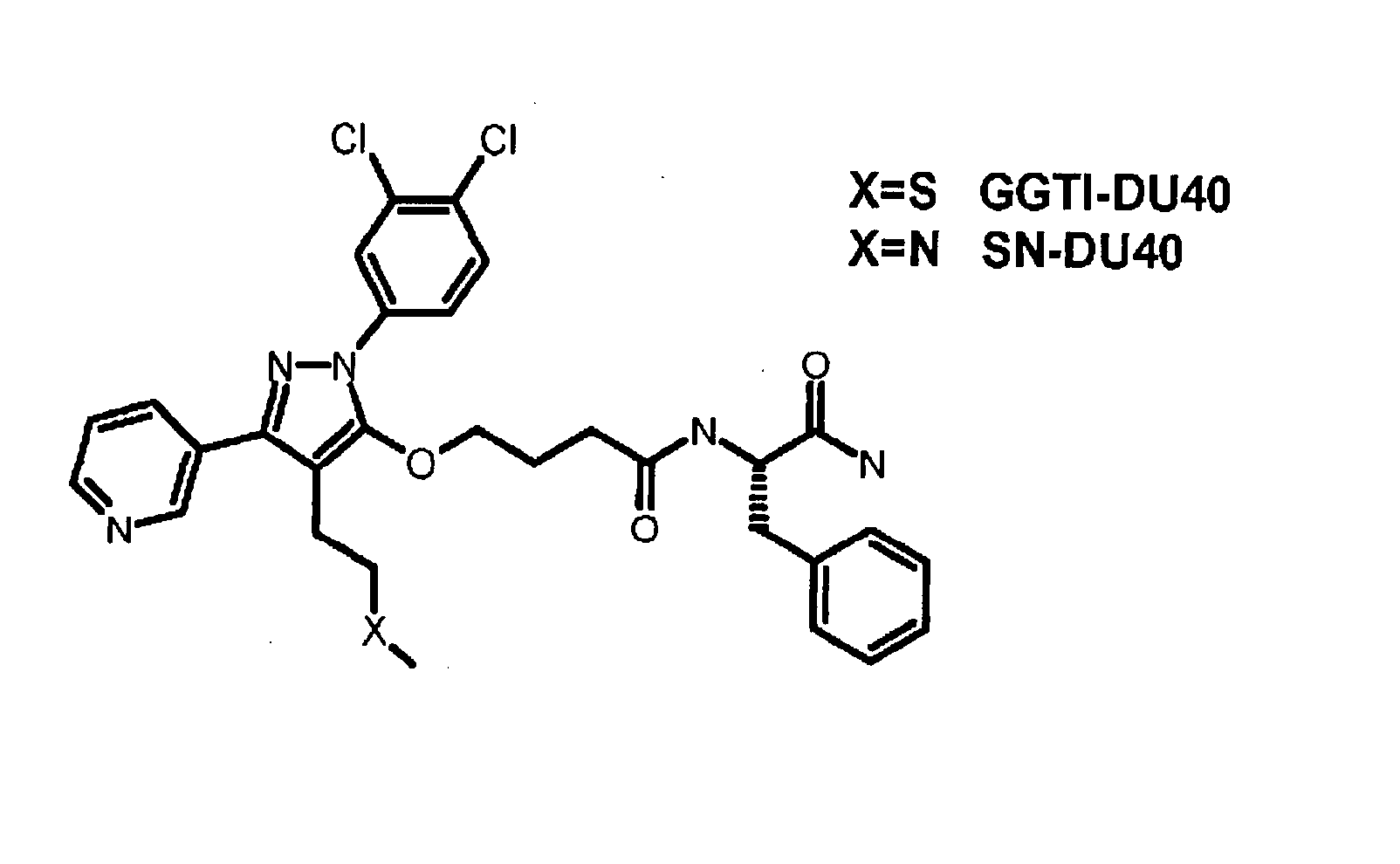Methods for treating glaucoma and macular degeneration
a technology for macular degeneration and glaucoma, applied in the field of eye diseases, can solve the problems of progressive impairment of central vision, no specific drug selectively targeting the tm pathway, and irreversible vision loss in older peopl
- Summary
- Abstract
- Description
- Claims
- Application Information
AI Technical Summary
Benefits of technology
Problems solved by technology
Method used
Image
Examples
example 1
Materials and Methods
[0057] Materials—Farnesyl diphosphate (FPP) and geranylgeranyl diphosphate (GGPP) were purchased from Biomol, Inc (Plymouth Meeting, Pa.). S-adenosine-L-methionine (AdoMet) was purchased from Sigma (St. Louis, Mo.). 3H-GGPP, 3H-FPP, and 3H-AdoMet were purchased from PerkinElmer (Boston, Mass.). Geneticin was purchased from Invitrogen (Carlsbad, Calif.). The FTI L-744,832 was purchased from EMD Biosciences (San Diego, Calif.). Streptavidin-Sepharose was purchased from Amersham Biosciences (Uppsla Sweden). Biotin-S-famsyl-L-cysteine was synthesized and purified as previously described (27). GGTI-DU40 and its inactive analog, SN-DU40, were synthesized by PPD Discovery (Research Triangle Park, N.C.) and by the Duke Small Molecule Synthesis Facility; the preparation of these compounds will be described elsewhere.
[0058] Enzyme Assays—FTase and GGTase-I activities were determined by following incorporation of radiolabeled isoprenoid from 3H-FPP and 3H-GGPP into Ras ...
example 2
Identification of GGTI-DU40, a Potent Inhibitor of GGTase-I
[0069] A diverse chemical library was screened for GGTase-I inhibitors using an in vitro assay, and a novel pyrazole-based inhibitor with an IC50 of ˜10 μM was discovered. Medicinal chemists at PPD Discovery (Research Triangle Park, N.C.) then optimized this structure for potency. The result of this optimization was a novel compound which we have dubbed GGTI-DU40 (FIG. 1A, N-[(S)-1-Carbamoyl-2-phenylethyl]-4-[2-(3,4-dichlorophenyl)-4-(2-methylsulfanylethyl)-5-pyridin-3-yl-2-H-pyrazol-3-yloxy]butyramide). The medicinal chemistry route to the refinement of this compound will be reported separately (J. P. Strachen et al, in preparation).
example 3
Kinetic Analysis of GGTase-I Inhibition by GGTI-DU40
[0070] In an initial examination of the selectivity of GGTI-DU40, the ability of the compound to inhibit GGTase-I and other enzymes in the prenylation pathway was determined (FIG. 1B). GGTI-DU40 was a highly potent inhibitor of purified GGTase-I exhibiting an IC50of 8.24+ / −0.97 nM. GGTI-DU40 inhibition of FTase was barely detectable in the concentration range tested, exhibiting an IC50 for this closely-related enzyme of >2 μM, corresponding to a FTase / GGTase-I selectivity ratio of >250. GGTI-DU40 showed no detectable activity against GGTase-II (Rab geranylgeranyltransferase) nor against Icmt methyltransferase (FIG. 1B). These data indicate GGTI-DU40 is a highly potent and selective inhibitor of GGTase-I. A structural analogue of GGTI-DU40, SN-DU40, that contains a single sulfur-to-nitrogen substitution (FIG. 1A), was also tested for GGTase-I inhibition. This single substitution resulted in a compound with an IC50 of >2 μM for GGT...
PUM
| Property | Measurement | Unit |
|---|---|---|
| body weight | aaaaa | aaaaa |
| body weight | aaaaa | aaaaa |
| time | aaaaa | aaaaa |
Abstract
Description
Claims
Application Information
 Login to View More
Login to View More - R&D
- Intellectual Property
- Life Sciences
- Materials
- Tech Scout
- Unparalleled Data Quality
- Higher Quality Content
- 60% Fewer Hallucinations
Browse by: Latest US Patents, China's latest patents, Technical Efficacy Thesaurus, Application Domain, Technology Topic, Popular Technical Reports.
© 2025 PatSnap. All rights reserved.Legal|Privacy policy|Modern Slavery Act Transparency Statement|Sitemap|About US| Contact US: help@patsnap.com



